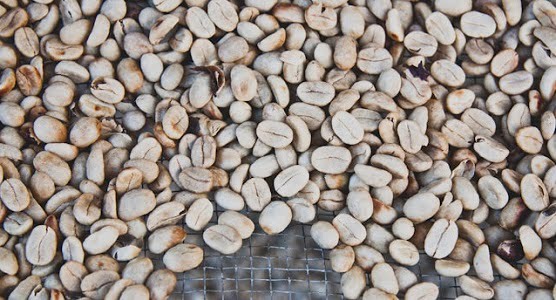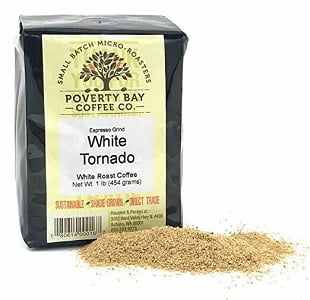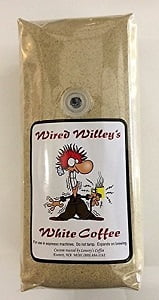As a self-professed coffee lover, I’m constantly on the hunt for new and fascinating coffee experiences. That’s why I was immediately intrigued when I first heard about “white coffee” – a unique type of coffee beans that produces a surprisingly distinct coffee drink.
Believe it or not, white coffee is not actually a coffee drink loaded with milk or creamers. Rather, it’s a special roasting process that results in a lighter, more unique flavor profile compared to traditional roasted coffee.
As an Amazon Associate, I earn commission from qualifying purchases.
What is White Coffee?
White coffee is a unique type of coffee made by roasting the beans for a very short period at a low temperature, around 300 to 320 Fahrenheit. This process results in beans that have an off-white or light beige color, unlike the dark brown hues of traditionally roasted coffee beans.
Due to the shorter roasting time, white coffee has a nutty and earthy flavor profile with a distinct astringency. The beans also retain a high moisture content, making them denser and harder than regular coffee beans.
These beans are much harder and less brittle compared to traditionally roasted coffee, so you can’t grind them in a typical home ceramic burr grinder. The density of the beans is almost as high as pebble stones, which can put significant strain on the motor and burrs of the grinder and possibly damage them.

What is the difference between White Coffee and Regular Coffee?
The main difference between white coffee and regular coffee lies in their roasting processes. Normal coffee beans are roasted at temperatures ranging from 380 to 450 degrees Fahrenheit, while white coffee is roasted at a much lower temperature of about 300 to 320 degrees for a brief period.
Actually, All types of coffee start as green beans after initial processing and white coffee is not unique. The mild roasting of white coffee turns the beans to a whitish-brown color, whereas regular coffee beans develop various shades of brown depending on the roast level.
Roasting is important in developing coffee flavors, with longer roasting times generally resulting in more complex and strong tastes.
In the roasting process, light roasts are typically removed from heat after the “first crack,” a popping sound that occurs as beans expand. White roast coffee is unique in that it’s removed even before this first crack occurs. In contrast, darker roasts are roasted past the “second crack,” resulting in oilier beans with more intense flavors.
Read a guide on Light vs Dark roast
The Origins of White Coffee
White coffee has its roots in the Arabian Peninsula, where it has been enjoyed for centuries. An old tradition in Yemen involves roasting coffee at a very low temperature, grinding it, and brewing it with a spice blend called Hawaij, which includes cinnamon, cardamom, ginger, and cloves.
White Coffee has gained popularity in the United States only recently in the last 10 years. The surge in interest can be attributed to various alleged health benefits associated with white coffee, which have caught the attention of health-conscious coffee lovers.
Does White Coffee have More Caffeine?
Yes, white coffee does have slightly more caffeine compared to regular coffee. This is because white beans are denser and contain more caffeine per volume than roasted beans.
For example, a scoop of white coffee will weigh more than the same scoop of dark roast, leading to a little more caffeine if you brew using scoops. But if you measure by weight there will be little to no difference.
Claims that white roast coffee has 50% more caffeine are exaggerated—realistically, it only has about 2-5% more caffeine at most. The caffeine content of coffee mainly depends on the origin and type of beans. For example, Robusta beans have double the amount of caffeine compared to Arabica.
What Does White Coffee Tastes Like?
White coffee has a distinct taste that is nutty, bright, and slightly acidic with no bitterness. It has subtle fruity and earthy notes, with astringency and hints of floral undertones. The body is light, almost tea-like, lacking the richness of regular roasted coffee. White coffee tastes nothing like coffee and more like strong nut milk.
Personally, I don’t particularly enjoy its taste. The flavors feel underdeveloped since many of the coffee flavors we typically enjoy come from caramelization during roasting, which white coffee lacks. That being said, you may like the taste of White Coffee but you have to understand it’s not a substitute for real coffee.
To make it more enjoyable, you can add milk, creamer, or spices like clove (as traditionally done in Yemen). On its own White coffee ain’t taste very nice!
Where to Buy White Coffee?
The best place to buy white coffee is from your local roaster, so you know they are fresh. Having them grind the beans for you is ideal, as you can’t grind them effectively in home grinders.
You can also find pre-ground white coffee options online. Always opt for pre-ground white beans to avoid issues with grinding at home.
Here are two recommended brands:
1. Poverty Bay White Tornado
This white coffee offers a sweet and nutty flavor profile. It’s ground to a fine espresso consistency, making it perfect for crafting delicious lattes coffee drinks.

2. Wired Willey’s White Roast
Wired Willey’s White Coffee has a nice smooth, nutty flavor with absolutely no bitterness. It comes in a fine espresso grind and works well for both lattes and straight espresso shots.

How to Brew White Coffee?
The best method for brewing white bean coffee is to use an espresso machine. The high pressure helps extract flavors from the dense beans, and it’s ideal to pull a longer espresso shot, known as a lungo.
Lungo Shot involves extracting the espresso for around 40 seconds and using more water than a standard espresso pull. The longer extraction time and increased water volume help draw out the subtle flavors from the dense white coffee beans.
You can also brew white beans using a Moka pot or AeroPress, both of which work well for these dense beans.
White coffee doesn’t really work well with Pour-over, French Press, or Drip brewing machines. The dense structure of the coffee can prevent the beans from being fully extracted, resulting in a flat, underdeveloped taste.
If you do choose to use a pour-over, consider doing a second pour-over with the same grounds to extract more flavors.
For a tasty and balanced cup, you can blend white beans with some regularly roasted coffee beans. The added flavors from the darker roast will complement the nutty, delicate notes of the white coffee, creating a more complex and harmonious coffee drink.
Are There Any Health Benefits to Drinking White Coffee?
There are claims that white coffee may offer more health benefits compared to traditional coffee, but the research on this is limited.
Some studies suggest that the lighter roasting process helps white beans retain more chlorogenic acid and antioxidants that are typically found in plant-based foods.
Antioxidants like chlorogenic acid can help protect cells from damage caused by harmful free radicals. However, while there may be potential benefits, more research is needed to fully understand how white coffee benefits health.
Some Popular White Coffee Drinks That Are Different from White Beans
White coffee doesn’t only refer to the lightly roasted beans that we have been discussing till now. There are also some cultural white coffee drinks that are popular in different parts of the world.
Malaysian Ipoh White Coffee
Ipoh White Coffee is a popular Malaysian coffee drink. It is made using beans that are roasted in margarine, which gives it a unique buttery and caramelized flavor profile. The coffee is then served with condensed milk, resulting in a deliciously creamy and sweet drink.
Lebanese white coffee
Lebanese White Coffee, or “Kahweh Baida,” is a traditional drink made with hot water and orange blossom water, sweetened with sugar. Unlike regular coffee, it contains no coffee or caffeine. It is a popular drink in Lebanon and other Arab countries, known for its soothing properties, and is often served after meals.
Check out Guides on other Coffee Varieties



